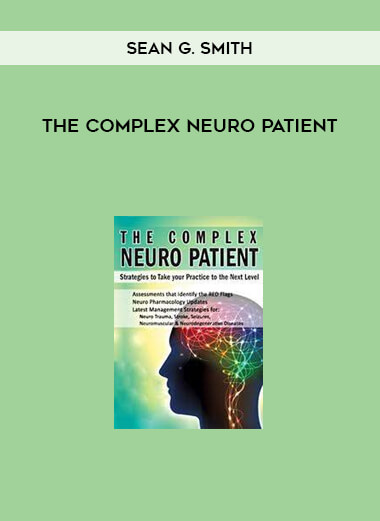Courses Infomation
The Complex Neuro Patient from Sean G. Smith
 The Complex Neuro Patient Strategies to Take Your Practice to the Next Level from Sean G. Smith
The Complex Neuro Patient Strategies to Take Your Practice to the Next Level from Sean G. Smith
Faculty:Sean G. Smith
Duration:Full Day | Format:Audio and Video
Archive : The Complex Neuro Patient from Sean G. Smith
Description:
Evaluations that Spot the RED Flags
Updates in Neuropharmacology
Newest Management Techniques for Neurodegenerative, Neuromuscular, Stroke, and Neurotrauma Conditions
This may sound familiar to you.
Joe, 78, arrives to the emergency room complaining of a headache that won’t go away, vision that is a little fuzzy today, and increased dizziness. As his wife informs you that something is “not right,” he appears even more perplexed. Joes claims that he only has the “flu,” which everyone gets at this time of year. He is baffled as to why his wife forced him to come in.
What Joe omitted from the narrative:
He hadn’t told his wife about the fall he had on the ice two days prior since he didn’t want her to worry. He has been taking aspirin instead in the hopes that his headache would just go gone.
Healthcare professionals must be able—and confident—enough to promptly detect these changes and intervene as needed because neurological symptoms can appear in patients at any moment. Are you certain that you possess the abilities required to recognize the subtle variations in the absence of the crucial piece of information that Joe omitted from the story? Are you equipped to handle the crisis that is taking place right in front of you?
Join Sean Smith, RN, BSN, NREMT-P, C-NPT, CCRN, CMC, CFRN, FP-C, CPEN, a renowned speaker and specialist in neurological nursing, for an in-depth examination of the difficult neuro patient. To give patients and their families the finest and most modern care possible, every nurse must be aware of these crucial ideas. Sean has a reputation for being able to simplify and apply difficult ideas. The difference between a successful and unsuccessful outcome in your next neurological emergency might be determined by your readiness to register now.
OUTLINE
Assessing the RED Flags in Neuro tests
Difficult Mental Status Exams
The Individual with a History of Dementia
The Cranial Nerve Assessment: Down-and-Dirty
Glasgow Coma Scale: Recognizing Warning Signs
Effective Change Communication
The Most Recent Evidence-Based Treatments for Neuro Trauma
Injury Types: Blunt & Penetrating
Management of symptoms for:
Hypoxemia
Hypotension
Prophylactic Hypothermia
nutritional substitution
Normoglycemia
Hyperventilation
Emergency Surgery & Post-Op Care
Mental Status and Cognitive Changes Related to Craniotomies and Craniectomies
Taking Care of Higher Intracranial Pressure
Late & Early Symptoms
Monitoring: Non-invasive vs. Invasive
Easy ICP Waveform Analysis
New Perspectives on Age-Old Therapies in Neuropharmacology
Steroids
Odorous Diuretics
High-Tongue Saline
Anti-Seizure Prevention
DVT Prevention
Agents for Reversing Anticoagulation and Thrombolysis
Prevention of Infection
Analgesics, sedatives, and anesthetics
Stroke Syndromes: Timely Recognition and Treatment Recommendations
Ischemic Stroke, Acute
NIH Findings on Intracerebral Hemorrhagic Strokes Stroke Scale Clinical Presentation and Seizure Management
Psychogenic Non-Epileptic Seizures (PNESs): Differentiation of Seizure Type
Epilepsy-Related Sudden Unexplained Death (SUDEP)
Neuromuscular & Neurodegenerative Disease
The Alzheimer’s Patient Evaluating Changes in Mental Status
The Individual with a History of Dementia
How to Recognize Subtle Cues and Differentiate a Diagnosis by Symptom Onset
The Multiple Sclerosis Patient
Physical Evaluation Obstacles
The patient with wasted & weak muscles
Key Parameters for Baseline Assessment
The Acute Amyotrophic Lateral Sclerosis Patient
Prepare for Complications
Identification of Life-Threatening Symptoms Early
What supplies MUST be available at the bedside?
challenging airway management
The Parkinson’s Disease Patient
Management of Symptoms Challenges
Strategies for Effective Patient Compliance Team Approach: The Role of the Interdisciplinary Team and Family Interventions for the Agitated Patient
OBJECTIVES
Analyze the applicability of neuroanatomy to complicated neurologic cases.
Analyze the methods of neurologic evaluation and the alterations brought on by pathological circumstances.
Select from several head injury kinds, corresponding mental states, and cognitive alterations.
Disseminate the most recent methods for swiftly diagnosing and treating stroke symptoms.
Indicate the types of seizures, their clinical manifestations, and suggested treatments.
Establish a connection between elevated intracranial pressure, anticipated reasons, and critical care management.
Analyze the post-operative care given to neurosurgical patients.
Dissect the key treatment modalities for individuals with neuromuscular and neurodegenerative illnesses.
Salepage : The Complex Neuro Patient from Sean G. Smith




![Peter Titus - Create Your Own Automated Stock Trading Robot In EXCEL! [39 Video (MP4) + 2 Document (HTML)]](https://crablib.info/wp-content/uploads/2021/02/Peter-Titus-Create-Your-Own-Automated-Stock-Trading-Robot-In-EXCEL-39-Video-MP4-2-Document-HTML.jpg)


























Reviews
There are no reviews yet.